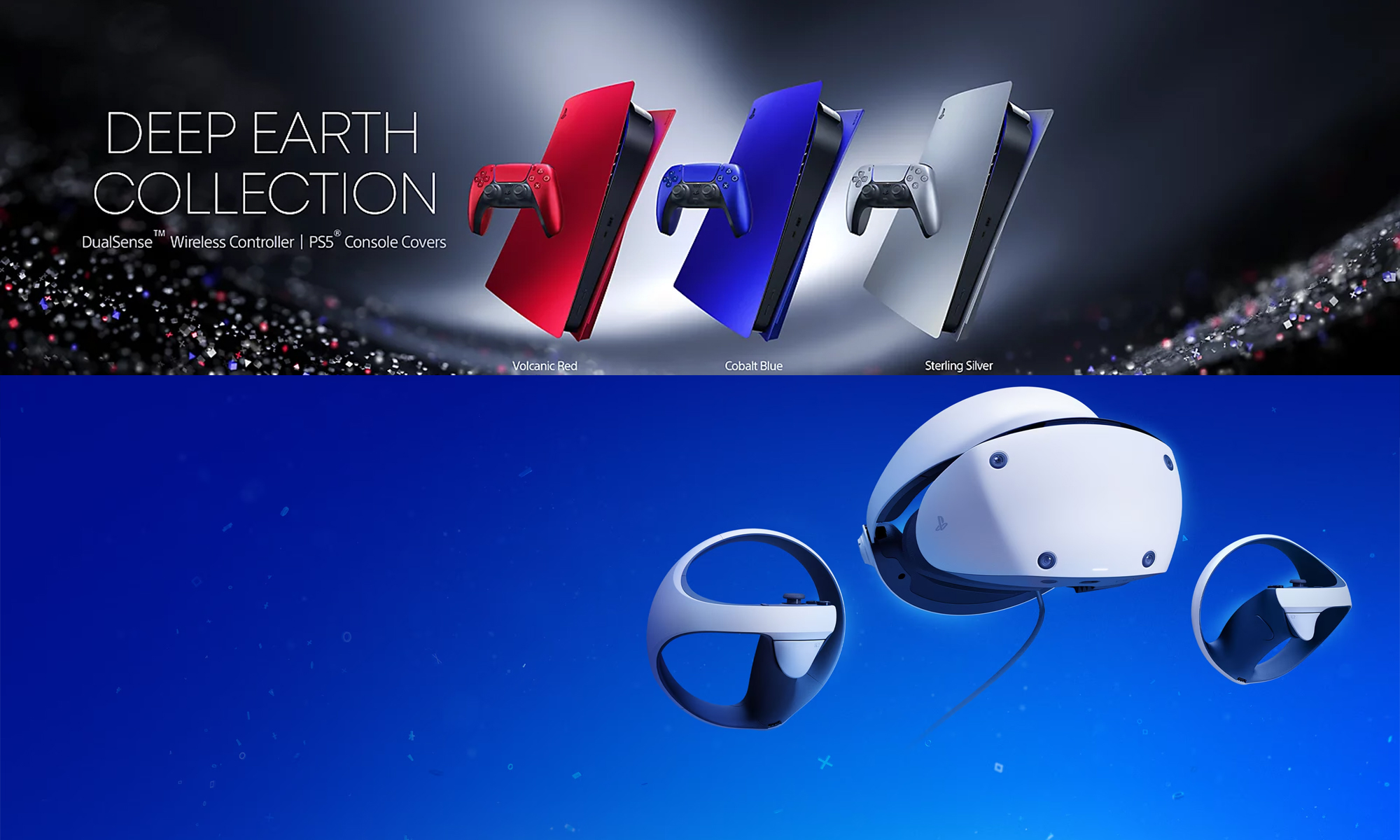Halo 3 theme by DJ Fukalya
Download: Halo3_4.p3t
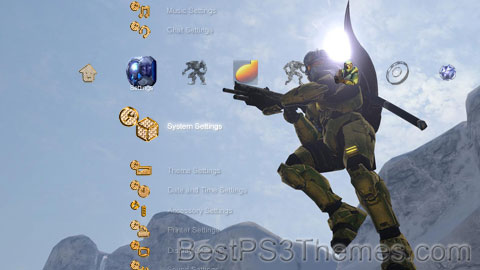
(16 backgrounds)
| Halo 3 | |
|---|---|
 | |
| Developer(s) | Bungie |
| Publisher(s) | Microsoft Game Studios |
| Producer(s) |
|
| Designer(s) |
|
| Programmer(s) |
|
| Artist(s) | Marcus Lehto |
| Writer(s) |
|
| Composer(s) | |
| Series | Halo |
| Platform(s) | Xbox 360 |
| Release | |
| Genre(s) | First-person shooter |
| Mode(s) | Single-player, multiplayer |
Halo 3 is a 2007 first-person shooter video game developed by Bungie for the Xbox 360 console. The third installment in the Halo franchise following Halo: Combat Evolved (2001) and Halo 2 (2004), the game's story centers on the interstellar war between 26th-century humanity, a collection of alien races known as the Covenant, and the alien parasite known as the Flood. The player assumes the role of the Master Chief, a cybernetically enhanced supersoldier, as he battles the Covenant and the Flood. In cooperative play, other human players assume the role of allied alien soldiers. The game features vehicles, weapons, and gameplay elements familiar and new to the series, as well as the addition of saved gameplay films, file sharing, and the Forge map editor—a utility which allows the player to perform modifications to multiplayer levels.
Halo 2 had originally been intended to wrap up the story begun with Combat Evolved, but development difficulties led to a cliffhanger ending. Bungie began developing Halo 3 shortly after Halo 2 shipped. The game was officially announced at E3 2006, and its release was preceded by a multiplayer beta open to select players who purchased the Xbox 360 game Crackdown. Microsoft spent $40 million on marketing the game, in an effort to sell more game consoles and broaden the appeal of the game beyond the established Halo fanbase. Marketing included cross-promotions and an alternate reality game.
Halo 3 was released on September 25 and grossed US$170 million on its first day of release, rising to $300 million in its first week. The game sold in excess of 14.5 million copies and was the best-selling video game of 2007 in the United States. More than one million people played Halo 3 on Xbox Live in the first twenty hours. Overall, the game was well received by critics, with the Forge and multiplayer offerings singled out as strong features; however, some reviewers criticized single-player aspects, especially the plot and campaign layout. Halo 3 is frequently listed as one of the greatest video games of all time. A sequel, Halo 4, released in November 2012, was developed by 343 Industries. Halo 3 was re-released as part of Halo: The Master Chief Collection for the Xbox One in November 2014 and for Microsoft Windows on July 14, 2020.[1]
Gameplay[edit]

Halo 3 is a shooter game where players primarily experience gameplay from a first-person perspective. Much of the gameplay takes place on foot, but also includes segments focused on vehicular combat. Gameplay focuses on the "Golden Triangle of Halo": players utilize weapons, grenades, and melee attacks, which are available to a player in most situations. Players may dual-wield some weapons for additional firepower, forgoing the use of grenades and melee attacks. Unlike previous installments, the player's secondary weapon is visible on their player model, holstered or slung across the player's back.[2] Halo 3 introduces support weapons, cumbersome two-handed weapons that slow the player when carried, but offer greatly increased firepower in return.[3]
In addition to weapons, Halo 3 contains a new class of gear called equipment;[4] these items have various effects, ranging from defensive screens to shield regeneration and flares. Only one piece of equipment can be carried at a time.[5] The game's vehicular component has been expanded with new drivable and AI-only vehicles.[6][7]
Halo 3 contains non-gameplay additions, such as Forge, a map-editing tool. Forge enables players to insert and remove game objects, such as weapons, crates and vehicles into existing multiplayer maps.[7] Almost all weapons, vehicles, and interactive objects can be placed and moved on maps with Forge.[8] Players can enter Forge games and edit and manipulate objects in real time. A budget limits the number of objects that can be placed.[9] Players may also save up to 100 films of gameplay to their Xbox 360's hard drive,[10][11] viewing the action from any angle and at different speeds.[12] Halo 3 offers a form of file sharing, where items such as saved films, screenshots, and custom variants can all be uploaded to Bungie's official website. Anyone can browse user created content that has been uploaded to Bungie's website and tag it to automatically download to their console next time they sign into Xbox Live on Halo 3.[5][13]
Modes[edit]
Halo 3's story or campaign mode can be played alone or cooperatively with up to three other players via Xbox Live or System Link. Instead of each player being an identical character in cooperative play, as in previous Halo games, the first player plays as Master Chief, the second player as the Arbiter, and the final two players controlling the Covenant Elites N'tho 'Sraom and Usze 'Taham. Each player has identical abilities, although their starting weapons vary.[14] Hidden skulls found on each level cause changes to the gameplay when enabled, such as giving the enemies extra health, changing in-game dialogue, or modifying AI behavior.[15] These skulls, as well as the difficulty level and the speed at which the level is completed, provide multipliers to the total score.[5] Players are awarded gamerscore points for unlocking Achievements by reaching a certain score in each level.[16]
Local area network or Xbox Live supports up to sixteen players in multiplayer matches, with game modes including variations of deathmatch and Capture the Flag. Players must actively seek out other players through their Xbox Live Friends list, using the party invite system, or the LAN search feature to play multiplayer matches with their own custom rules and customized maps. If they are connected to Xbox Live however, a player can choose to have the game decide for them the exact rules and map to play on, as well as finding additional people to play against or with, using the "Matchmaking" system (the automated grouping of players of similar skill). A player will decide from a selection of developer designed "playlists" which each contain a certain way to experience the game.[17]
Like other multiplayer Xbox 360 titles, Halo 3 uses a customized version of TrueSkill ranking system for its matchmaking on a per-playlist basis. A linear measure of a player's experience with the matchmade portion of the game and each particular playlist is also tracked (denoted as EXP).[18] To help players have an enjoyable time online, several peace-of-mind features are implemented within easy reach, such as avoid/feedback options on a player's service record, as well as voice chat mute straight from the in-game scoreboard.[19] Like Halo 2, Halo 3 supports downloadable content and updates.[20] The online services for the original Xbox 360 version of the game went offline in January 2022.[21]
Synopsis[edit]
Setting and characters[edit]
Halo 3 is set in a science fiction setting during the years 2552 and 2553. Humanity is at war with a genocidal alliance of alien races known as the Covenant. After years of conflict, a Covenant fleet discovers Earth during Halo 2.[9] "Halos" are massive ringworlds, ranging from thousands to tens of thousands of kilometers in diameter, scattered across the galaxy. These rings were constructed thousands of years ago by a race known as the Forerunners as weapons of last resort against the parasitic alien species known as the Flood. When activated, the Halos would destroy all sentient life in the galaxy, depriving the Flood of its food. The Forerunners disappeared after they activated the rings. In Halo: Combat Evolved, whilst fleeing the Covenant, the UNSC ship Pillar of Autumn stumbled upon one of these ringworlds, Installation 04. Against the wishes of the ring's artificial intelligence (AI) caretaker, 343 Guilty Spark, the human supersoldier Master Chief destroyed the ring to stop the threat from Halo and the Flood. The Covenant, unaware of the destructive nature of the rings, attempt to fire another ring, Installation 05, during Halo 2 in order to fulfill their religious prophecy. One race in the Covenant, the Elites, learn the truth about the rings, and join forces with humanity in order to stop the installation's firing. Though they are successful, the unexpected shutdown triggers a fail-safe protocol, priming all the rings for firing from one location, referred to as the Ark. Still oblivious to the true nature of the rings, the Covenant High Prophet of Truth and the remaining loyalist Covenant proceed to head to Earth, where they believe the Ark is buried.
Halo 3's protagonist is Master Chief Petty Officer John-117, an enhanced supersoldier known as a "Spartan". Master Chief fights alongside the Arbiter, a disgraced Covenant Elite commander. Two other Elite characters, N'tho 'Sraom and Usze 'Taham, appear as the third and fourth players in cooperative play.[14] Supporting characters from previous games return, including human soldiers Avery Johnson and Miranda Keyes.[9] Also playing a role in the story is the Flood leader known as the "Gravemind". In Halo 2, the Gravemind escapes from confinement, invades the Covenant mobile capital city of High Charity, and captures the human AI Cortana.[9]
Plot[edit]
After the events of the comic tie-in Halo: Uprising,[22] the Master Chief arrives on Earth in east Africa, where he is found by Johnson and the Arbiter. The Chief and company return to a UNSC outpost where Keyes and Lord Hood plan a final effort to stop the Covenant leader, the High Prophet of Truth, from activating a Forerunner artifact the Covenant have excavated. The Chief clears anti-air Covenant defenses so Hood can lead the last of Earth's ships against the Prophet, but Truth activates the buried artifact, creating a slipspace portal which he and his followers enter. A Flood-infested ship crash-lands nearby; Elite forces arrive and vitrify the Flood-infected areas of Earth, stopping the threat. Following a message Cortana left aboard the Flood ship, the Chief, Arbiter, Elites, Johnson, Keyes and their troops follow Truth through the portal. Joining them is 343 Guilty Spark, who aids the Chief as he has no function to fulfill after the destruction of his ringworld.
Traveling through the portal, the humans and Elites discover an immense artificial structure known as the Ark, far beyond the edges of the Milky Way galaxy. Here, Truth can remotely activate all the Halos. The Flood arrive aboard High Charity in full force, beginning to infest the installation. Truth captures Johnson, as he needs a human to use Forerunner technology. Keyes is killed attempting a rescue, and Johnson is forced to activate the rings. Gravemind forges a truce with the Chief and Arbiter to stop Truth and defeat the remainder of his army, rescuing Johnson and halting the installations' activation. After the Arbiter kills Truth, Gravemind turns on the Chief and Arbiter.
The Chief, Arbiter and Guilty Spark discover that the Ark is constructing another Halo to replace the one that the Chief previously destroyed. The Chief decides to activate this Halo; the ringworld would eliminate the Flood infestation on the Ark while sparing the galaxy at large from destruction. To activate the ring, the Chief rescues Cortana, who has the Activation Index of the destroyed Halo, from High Charity and destroys the city. Arriving on the new Halo, Cortana warns that Gravemind is trying to rebuild itself on the ring. The Chief, Arbiter, and Johnson travel to Halo's control room to activate the ring. Guilty Spark explains that because the ring is not yet complete, a premature activation will destroy it and the Ark. When Johnson ignores his warning, Guilty Spark fatally wounds him to protect "his" ring. Although the Chief destroys Guilty Spark, Johnson soon dies of his injuries. Chief activates the ring, and escapes the ring's self-destruction on the UNSC frigate Forward Unto Dawn. However, the force of Halo's blast causes the slipspace portal to collapse, resulting in only the front half of Forward Unto Dawn, carrying the Arbiter, making it back to Earth.
A memorial service is held on Earth for the fallen heroes of the Human-Covenant war, during which the Arbiter and Lord Hood briefly exchange words regarding the fallen Master Chief. After the memorial service, the Arbiter and his Elite brethren depart for their home planet. Meanwhile, the rear half of the Forward Unto Dawn drifts in unknown space. Cortana drops a distress beacon, but acknowledges it may be many years before they are rescued. As the Master Chief enters cryonic sleep, Cortana confides to him that she will miss him, but he comforts her by telling her "wake me when you need me." If the game is completed at the Legendary difficulty level, the scene continues to show the piece of Forward Unto Dawn drifting towards an unknown planet, setting up the events of Halo 4.
Development[edit]
Halo 2 was a critical and commercial success, but its development had taken a toll on Bungie. The game's development was fraught and rushed, resulting in the final act of the game's campaign being cut.[23] Bungie was openly critical of the game's shortcomings,[24] and viewed a third Halo game as a chance to do right by fans for Halo 2's problems, as well as the final Halo game the studio would make before moving onto other projects. Lingering dissatisfaction with Bungie's acquisition by Microsoft in 2000 and a desire for more favorable profit-sharing on Halo 3 led to an agreement where Bungie would become an independent studio after shipping a set number of new Halo games.[23]
After Halo 2 shipped, Bungie cofounder Jason Jones went on sabbatical, leaving the Halo 3 team with little direction or leadership; different staff members wrestled over who would take on creative positions for the new game, and no clear creative direction was decided upon. Story writer Joseph Staten took a vacation after coming into conflict with other staff members, meaning there was no clear person who was responsible for the game's story for a portion of development. The story was drafted by a committee, then presented to senior Bungie members. Composer Martin O'Donnell recalled he did not feel the draft would work, as it left out previous characters and plot threads. Having recently seen the film Serenity, he insisted that characters should die to increase the stakes. Staten returned to do edits after the plot had been established.[23]
Halo 2 had popularized online multiplayer matchmaking and social features like player parties and voice chat. The Xbox 360 integrated many similar features into Xbox Live, but changed the underlying system. Designer Max Hoberman recalled that instead of creating new features, he spent a year fixing broken features to get back to parity with Halo 2.[23]
Compared to the harried pace of Halo 2's development which necessitated painful cuts to ship the game on time, Bungie staffers recalled Halo 3's development as much more smooth, with more time to add features like Forge mode.[23]
Bungie remained quiet as to what their new project was, leaving comments in their weekly update alluding to a "new project".[25] The game was officially announced with a real-time cinematic trailer at E3 2006.[26]
In comparison with Halo 2's tight-lipped development, Bungie was more transparent about the process for Halo 3.[23] Bungie kept the public informed on game development via weekly updates on their web site. During development, the game was divided into single player and multiplayer builds; this made debugging and testing the much smaller multiplayer files quicker.[27] While details of Halo 3's multiplayer were widely disseminated in the sixteen months leading up to the release,[28] the single-player aspect of the storyline was kept relatively secret throughout much of the development to build up interest. The first campaign screenshots did not appear until a year after the announcement trailer, on July 5, 2007, as a "tease" for the planned pace of marketing.[29]
A public beta test of the game's online multiplayer features, as well as saved films and file share, took place four months before the full release.[30] Players required a Crackdown disc to play the beta.[31]
AI behavior was enhanced and improved; the behavior of enemy Brutes the player faces was modified, giving them a "pack mentality" that causes the aliens to perform similar actions at the same time and altering gameplay.[4][32]
Graphics[edit]
Halo 3 utilizes a proprietary, in-house graphics engine.[33] It employs graphics technologies such as high dynamic range, global lighting, and depth of field effects within cutscenes.[34] Motion blurring was absent from the beta, but was added to the final game.[35] Most dynamic objects in the game cast real-time shadows on themselves and the environment around them, including the game's plant life. Halo 3 uses normal, bump, and parallax mapping to give surfaces more detail without dramatically increasing the number of polygons. Players can see distances of up to ten miles (16 km) away, all fully three-dimensional.[36] The engine is capable of real-time reflections, but are often unused as Bungie considered it a waste of resources.[37] Halo 3 uses two frame buffers instead of the usual single buffer, allowing Bungie to preserve as much of dynamic range as possible for the game's lighting without adversely affecting the frame rate. As a consequence, the game natively renders at 1152×640 resolution instead of 720p. The image can be upscaled to 1080p by the Xbox 360.[38][39] Halo 3 has also been enhanced for Xbox One X, rendering at 1920p upscaled to 2160p in HDR at a solid 30fps.[40]
Audio[edit]
As with all titles on the Xbox 360, Halo 3 fully supports 5.1 surround sound audio.[41] In the game, there are over 50,000 pieces of audio, with nearly 40,000 of those being NPC dialogue.[5] This is far more than in either of the preceding Halo titles; Halo 2 had over 15,000 pieces of dialogue. The AI controlling this dialogue is designed to ensure the exchanges flow naturally and convincingly.[36] Separate recordings were made for nearby and distant gunfire to make for a more believable sound experience in the public beta,[42] and the finished game uses Waves Audio plugins to modify dialog and other audio in-game depending on conditions.[43] Distant gunfire sounds, which may first seem like pre-recorded ambient sound, may often be the result of an actual firefight happening elsewhere in the game.[44]
Marty O'Donnell again composed the original score for the game. Some pieces of the game's music are produced with a much larger real orchestra than any pieces in the prior two games. For example, the music for the announcement trailer was recorded with a 60-piece orchestra and a 24-piece choir.[26] Halo 3 is the first game in the series to feature custom soundtracks, allowing players to replace in-game music with their own choices.[45] The Halo 3 Original Soundtrack was released on November 20, 2007.[46] Included on the soundtrack is an original composition submitted by fans and judged by Nile Rodgers, Michael Ostin, and Marty O'Donnell.[47]
Voice actors returning to reprise their roles in Halo 3 include Jen Taylor as Cortana, David Scully as Sergeant Johnson and the Elites, Keith David as the Arbiter, Tim Dadabo as 343 Guilty Spark, Ron Perlman as Lord Hood, Robert Davi as Rtas 'Vadum, and Steve Downes as the voice of Master Chief. The game also features new voices, with Terence Stamp and Justis Bolding replacing Halo 2 voice actors Michael Wincott and Julie Benz as the Prophet of Truth and Miranda Keyes respectively.[48] Additional voices include celebrity presenter Jonathan Ross,[49] Nathan Fillion, Adam Baldwin, Alan Tudyk, Katee Sackhoff, and John DiMaggio.[48] Members of the Halo machinima Red vs. Blue (Burnie Burns, Gus Sorola, Matt Hullum, Jason Saldaña, Geoff Ramsey, and Joel Heyman) have cameo roles.[9]
Release[edit]

Microsoft spent more than $40 million marketing Halo 3. The goal of the campaign was to sell more Xbox 360 consoles and widen the appeal of the game beyond the "Halo faithful" to casual as well as hardcore gamers. Marketing took the form of stages, including trailers of the game, real-time cinematics, recorded gameplay sequences, pre-rendered CGI, and live action film.[50] On September 12, 2007, the "Believe" Halo 3 ad campaign, focused on the epic nature of the story and heroism told through dioramas and third party accounts of Master Chief's service, began with the video "Museum" and continued on past the game's release.[51]
Throughout the course of development Bungie released four "developer documentaries" that explained the processes behind creating parts of the game. A large-scale multiplayer beta test was played on Xbox Live with more than 800,000 members of the public being able to take part and experience the game for themselves.[50] Beginning in June 2007, an alternate reality game called Iris involved players in slowly revealing background information for the game.[50] The actual release was met with worldwide launch parties.[52]
Halo 3 also had marketing tie-ins and promotions. PepsiCo announced a new line of soft drink, a variant of Mountain Dew named Game Fuel, branded with the Halo 3 logo and the Master Chief.[53] Much of the advertising focused on appealing to the general public, rather than just hardcore fans of the game; for example, some 7-Eleven stores advertised Halo 3 and sold specialty cups and copies of the game.[54] Gamestation stores in the UK offered a limited edition Master Chief figurine to the first 1000 preorders.[55]
The game's final testing copy before its gold release—codenamed "Epsilon" and confirmed by Bungie to be almost complete[13]—was leaked to the Internet months before the game's release date. Microsoft reacted to this leak by having the Xbox Live accounts of gamers caught playing the leaked copy banned until the year 9999.[56] Retail copies of the game, complete with photographs of the open game box, started to appear on the internet auction site eBay weeks before release,[57] followed by UK catalog retailer Argos accidentally releasing some of their copies a week early. Microsoft's Entertainment and Devices division were quoted as being "disappointed" that the Argos leak happened, but stated they had no intention for punishing them for an "honest mistake".[58] The retail copy was also leaked online over a week before release, with the 6.14 gigabyte file of the game ripped from a disc and downloaded by thousands of people within 24 hours. Videos of the ending of Halo 3, obtained from the leaked copy, were captured and posted on video sharing sites.[59]
Halo 3 was released on September 25, 2007, in three separate retail versions: "Standard", "Limited", and "Legendary". The Standard Edition contains the game disc, manual, and a small poster with the game's control-map and artwork. The Limited Edition, contained in a metal case, contains the game disc, manual, poster, Xbox 360 bonus disc with featurettes, and a hardcover-bound "Bestiarum", a collection of information and art covering the species, cultures, and civilizations of Halo 3. The Legendary Edition contains the game disc, manual, poster, interactive bonus disc, the Bestiarum on a DVD, Legendary DVD containing exclusive content, and a scale replica of the Master Chief's helmet as a case for the three discs. The slip-cover packaging unfolds into a large heavy-stock poster of Master Chief.[60] Some of the Limited Edition versions of Halo 3 were found to have a defect in the hub that kept the discs in place, which could lead to scratched discs. Microsoft introduced a disc replacement program in response.[61][62]
On the day before its official release, 4.2 million units of Halo 3 were in retail outlets.[63]
Halo 3 was made a free download for Xbox Live Gold subscribers through the "Games with Gold" program in October 2013.[64] It became playable on the Xbox One via backwards compatibility in 2017.[65] An Xbox One-native version of the game, presenting the graphics at 1080p and 60 frames per second, was included as part of Halo: The Master Chief Collection for the Xbox One in 2014. Halo 3 was re-released again as part of the Windows version of The Master Chief Collection in 2020.[66]
Downloadable content[edit]
Halo 3 supports multiplayer map downloadable content as well as game updates via Xbox Live.[67] The first three post-release multiplayer maps, "Standoff", "Rat's Nest", and "Foundry", were released as a pack on December 11, 2007, collectively known as the "Heroic Map Pack".[68] A second group of three maps including a remake of Halo 2 map "Lockout", titled "Blackout", a new map "Ghost Town" and a remake of Halo: Combat Evolved map "Sidewinder", titled "Avalanche" were bundled as the "Legendary Map Pack", on April 15, 2008.[69] These maps introduced visual filters to the Forge pallet, which change the way the maps look.[70] A remake of the Halo: Combat Evolved map "Chill Out", titled "Cold Storage", was released as a free download on "Bungie Day", July 7, 2008.[71] The third multiplayer map pack, titled the "Mythic Map Pack" and consisting of the maps "Orbital", "Assembly", and "Sandbox", was included with the Limited Collectors Edition of Halo Wars.[72] The map pack was released over the Xbox Live Marketplace on April 9, 2009.[73] The fourth and final multiplayer map pack, "Mythic II Map Pack", was released on February 2, 2010. The map pack includes the three new maps from Halo 3: ODST
Daft Punk
Daft Punk theme by Yvon12
Download: DaftPunk.p3t
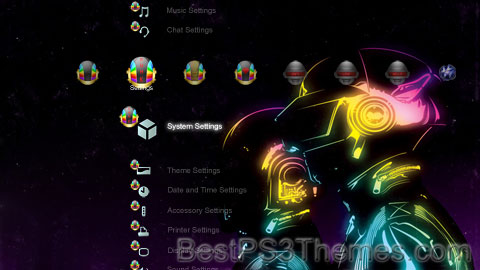
(1 background)
| Daft Punk | |
|---|---|
 Thomas Bangalter and Guy-Manuel de Homem-Christo in 2013 | |
| Background information | |
| Origin | Paris, France |
| Genres | |
| Discography | |
| Years active | 1993–2021 |
| Labels |
|
| Past members | |
| Website | daftpunk |
Daft Punk were a French electronic music duo formed in 1993 in Paris by Thomas Bangalter and Guy-Manuel de Homem-Christo. They achieved early popularity in the late 1990s as part of the French house movement, combining elements of house music with funk, disco, techno, rock and synth-pop.[1] The duo garnered further acclaim and commercial success and are now regarded as one of the most influential acts in dance music history.[2]
Daft Punk formed after Bangalter and de Homem-Christo's former indie rock band, Darlin', disbanded. Their debut studio album, Homework, was released by Virgin Records in 1997 to positive reviews, backed by the singles "Around the World" and "Da Funk". From 1999, Daft Punk assumed robot personas for public appearances, with helmets, outfits and gloves to disguise their identities; they made few media appearances. They were managed from 1996 to 2008 by Pedro Winter, the head of Ed Banger Records.
Daft Punk's second album, Discovery (2001), earned acclaim and further success, with the hit singles "One More Time", "Digital Love" and "Harder, Better, Faster, Stronger". It became the basis for an animated film, Interstella 5555, supervised by the Japanese artist Leiji Matsumoto. Daft Punk's third album, Human After All (2005), received mixed reviews, though the singles "Robot Rock" and "Technologic" achieved success in the United Kingdom. Daft Punk directed an avant-garde science-fiction film, Electroma, released in 2006. They toured throughout 2006 and 2007 and released the live album Alive 2007, which won a Grammy Award for Best Electronic/Dance Album; the tour is credited for broadening the appeal of dance music in North America. Daft Punk composed the score for the 2010 film Tron: Legacy.
In 2013, Daft Punk left Virgin for Columbia Records and released their fourth and final album, Random Access Memories, to acclaim; the lead single, "Get Lucky", reached the top 10 in the charts of 27 countries. Random Access Memories won five Grammy Awards in 2014, including Album of the Year and Record of the Year for "Get Lucky". In 2016, Daft Punk gained their only number one on the Billboard Hot 100 with "Starboy", a collaboration with the Weeknd. In 2015, Rolling Stone ranked them the 12th greatest musical duo of all time; the same publication has included two of their albums on their list of the 500 Greatest Albums of All Time. They announced their split in 2021.
History[edit]
1987–1992: Early career and Darlin'[edit]

Guy-Manuel de Homem-Christo and Thomas Bangalter met in 1987 while attending the Lycée Carnot secondary school in Paris.[3][4] The two became friends and recorded demos with others from the school.[5][6] In 1992, they formed a band, Darlin', with Bangalter on bass, Homem-Christo on guitar,[5][6] and Laurent Brancowitz on guitar and drums.[7] The trio named themselves after the Beach Boys song "Darlin'", which they covered along with an original composition.[7] Both tracks were released on a multi-artist EP under Duophonic Records, a label owned by the London-based band Stereolab, who invited Darlin' to open for shows in the United Kingdom.[7]
Darlin' disbanded after around six months, having played two gigs and produced four songs. Bangalter described the project as "pretty average".[8] Brancowitz formed another band, Phoenix.[8] Bangalter and Homem-Christo formed Daft Punk and experimented with drum machines and synthesizers.[citation needed] The name was taken from a negative review of Darlin' in Melody Maker by Dave Jennings,[9] who dubbed their music "a daft punky thrash".[10] The band found the review amusing.[4] Homem-Christo said, "We struggled so long to find [the name] Darlin', and [this name] happened so quickly."[11]
1993–1996: First performances and singles[edit]
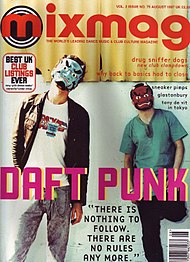
In September 1993, Daft Punk attended a rave at EuroDisney, where they met Stuart Macmillan of Slam, the co-founder of the Scottish label Soma Quality Recordings.[4][12] They gave him a demo tape, which formed the basis for Daft Punk's debut single, "The New Wave", a limited release in 1994.[8] The single also contained the final mix of "The New Wave" called "Alive", which appeared on Daft Punk's first album.[13]
Daft Punk returned to the studio in May 1995 to record "Da Funk". After it became their first commercially successful single, they hired a manager, Pedro Winter, who regularly promoted them and other artists at his Hype nightclubs.[6] They signed with Virgin Records in September 1996 and made a deal to license tracks through their production company, Daft Trax.[3][6] Bangalter said that while they received numerous offers from record labels, they wanted to wait and ensure that they did not lose creative control. He considered the deal with Virgin more akin to a partnership.[14]
In the mid-to-late nineties, Daft Punk performed live at various events, without the costumes they later became known for. In 1996, they made their first performance in the United States, at an Even Furthur event in Wisconsin.[15] In addition to live original performances, they performed in clubs using vinyl records from their collection. They were known for incorporating numerous styles of music into their DJ sets.[16]
1997–1999: Homework[edit]
Daft Punk released their debut album, Homework, in 1997.[12] That February, the UK dance magazine Muzik published a Daft Punk cover feature and described Homework as "one of the most hyped debut albums in a long long time".[17] According to The Village Voice, the album revived house music and departed from the Eurodance formula.[18] The critic Alex Rayner wrote that it combined established club styles and the "burgeoning eclecticism" of big beat.[19] In 1997, Daft Punk embarked on an international concert tour, Daftendirektour, using their home equipment for the live stage.[8] On 25 May, they headlined the Tribal Gathering festival at Luton Hoo, England, with Orbital and Kraftwerk.[20]
The most successful single from Homework was "Around the World". "Da Funk" was also included on The Saint film soundtrack. Daft Punk produced a series of music videos for Homework directed by Spike Jonze, Michel Gondry, Roman Coppola and Seb Janiak. The videos were collected in 1999 as D.A.F.T.: A Story About Dogs, Androids, Firemen and Tomatoes.
Bangalter and Homem-Christo created their own record labels, Roulé and Crydamoure, after the release of Homework, and released solo projects by themselves and their friends. Homem-Christo released music as a member of Le Knight Club with Eric Chedeville, and Bangalter released music as a member of Together with DJ Falcon and founded the group Stardust with Alan Braxe and Benjamin Diamond. In 1998, Stardust released their only song, the chart hit "Music Sounds Better With You".[21]
1999–2003: Discovery[edit]
Daft Punk's second album, Discovery, was released in 2001. The duo said it was an attempt to reconnect with the playful, open-minded attitude associated with the discovery phase of childhood.[7] The album reached No. 2 in the UK, and its lead single, "One More Time", was a hit. The song is heavily autotuned and compressed.[7] The singles "Digital Love" and "Harder, Better, Faster, Stronger" were also successful in the UK and on the US Dance Chart, and "Face to Face" hit number one on the US club play charts.
Discovery created a new generation of Daft Punk fans. It also saw Daft Punk debut their distinctive robot costumes; they had previously worn Halloween masks or bags for promotional appearances.[22] Discovery was later named one of the best albums of the decade by publications including Pitchfork[23] and Resident Advisor.[24] In 2020, Rolling Stone included it at number 236 in its list of the "500 Greatest Albums of All Time".[25] In 2021, Pitchfork cited Discovery as the centrepiece of Daft Punk's career, "an album that transcended the robots' club roots and rippled through the decades that followed".[26]
Daft Punk partnered with the Japanese manga artist Leiji Matsumoto to create Interstella 5555, a feature-length animation set to Discovery. The first four episodes were shown on Toonami in 2001, and the finished film was released on DVD in 2003.[27] That December, Daft Punk released Daft Club, a compilation of Discovery remixes.[28] In 2001, Daft Punk released a 45-minute excerpt from a Daftendirektour performance as Alive 1997.[29]
2004–2007: Human After All and Alive 2007[edit]

In March 2005, Daft Punk released their third album, Human After All, the result of six weeks of writing and recording.[30] Reviews were mixed, with criticism for its repetitiveness and darker mood.[31] "Robot Rock", "Technologic", "Human After All" and "The Prime Time of Your Life" were released as singles. A Daft Punk anthology CD/DVD, Musique Vol. 1 1993–2005, was released on 4 April 2006. Daft Punk also released a remix album, Human After All: Remixes.[32]
On 21 May 2006, Daft Punk premiered a film, Daft Punk's Electroma, at the Cannes Film Festival sidebar Director's Fortnight.[33] The film does not include Daft Punk's music. Midnight screenings of the film were held in Paris theaters starting from March 2007.[34]
For 48 dates across 2006 and 2007, Daft Punk performed the Alive 2006/2007 world tour, performing a "megamix" of their music from a large LED-fronted pyramid. The tour was acclaimed[35] and is credited for bringing dance music to a wider audience, especially in North America.[36][37] The Guardian journalist Gabriel Szatan likened it to how the Beatles' 1964 performance on The Ed Sullivan Show had brought British rock and roll to the American mainstream.[36]
Daft Punk's performance in Paris was released as their second live album, Alive 2007, on 19 November 2007.[38] The live version of "Harder, Better, Faster, Stronger" was released as a single,[39] with a video directed by Olivier Gondry comprising audience footage of their performance in Brooklyn.[40] In 2009, Daft Punk won Grammy Awards for Alive 2007 and its single "Harder, Better, Faster, Stronger".[41]
2008–2011: Tron: Legacy[edit]

Daft Punk made a surprise appearance at the 50th Grammy Awards on 10 February 2008, and appeared with rapper Kanye West to perform a reworked version of "Stronger" on stage at the Staples Center in Los Angeles.[42] It was the first televised Daft Punk live performance.[42]
In 2008, Daft Punk returned to Paris to work on new material. Winter also stepped down as their manager to focus attention on his Ed Banger Records label and his work as Busy P.[43] He stated in a later interview that Daft Punk were working with an unspecified management company in Los Angeles. The duo held its Daft Arts production office at the Jim Henson Studios complex in Hollywood.[44] In 2008, Daft Punk placed 38th in a worldwide official poll of DJ Mag after debuting at position 71 in the year before.[45] Daft Punk provided new mixes for the video game DJ Hero, and appeared in the game as playable characters.[46]
At the 2009 San Diego Comic-Con, it was announced that Daft Punk had composed 24 tracks for the film Tron: Legacy.[47] Daft Punk's score was arranged and orchestrated by Joseph Trapanese.[48] The band collaborated with him for two years on the score, from pre-production to completion. The score features an 85-piece orchestra, recorded at AIR Lyndhurst Studios in London.[49] Joseph Kosinski, director of the film, referred to the score as a mixture of orchestral and electronic elements.[50] Daft Punk also make a cameo as disc jockey programs wearing their trademark robot helmets within the film's virtual world.[51] The soundtrack album was released on 6 December 2010.[52] A music video for "Derezzed" premiered on the MTV Networks on the same day the album was released.[53] The video, which features Olivia Wilde as the character Quorra in specially shot footage, along with images of Daft Punk in Flynn's Arcade, was later made available for purchase from the iTunes Store and included in the DVD and Blu-ray releases of the film. Walt Disney Records released a remix album, Tron: Legacy Reconfigured, on 5 April 2011.[54]
In 2010, Daft Punk were admitted into the Ordre des Arts et des Lettres, an order of merit of France. Bangalter and Homem-Christo were individually awarded the rank of Chevalier (knight).[55] On October of that year, Daft Punk made a surprise guest appearance during the encore of Phoenix's show at Madison Square Garden in New York City. They played a medley of "Harder, Better, Faster, Stronger" and "Around the World" before the song segued into Phoenix's song "1901". The duo also included elements of their tracks "Rock'n Roll", "Human After All", and "Together", one of Bangalter's releases as a member of Together.[56] They produced N.E.R.D.'s 2010 song "Hypnotize U".[57]
2011–2015: Random Access Memories[edit]

In 2011, Soma Records released a previously unpublished Daft Punk track, "Drive", recorded while they were signed to Soma in the 1990s. The track was included in a twentieth anniversary multi-artist compilation of the Soma label.[58][59] In October 2012, Daft Punk provided a 15-minute mix of songs by blues musician Junior Kimbrough for Hedi Slimane's Yves Saint Laurent fashion show.[60] Daft Punk recorded their fourth studio album, Random Access Memories, with musicians including Julian Casablancas, Todd Edwards, DJ Falcon, Panda Bear, Chilly Gonzales, Paul Williams, Pharrell Williams, Chic frontman Nile Rodgers and Giorgio Moroder.[61][62][63][64][65][66] Daft Punk left Virgin for Sony Music Entertainment through the Columbia Records label.[67]
Random Access Memories was released on 17 May 2013.[68] The lead single, "Get Lucky", became Daft Punk's first UK number-one single[69] and the most-streamed new song in the history of Spotify.[70] At the 2013 MTV Video Music Awards, Daft Punk debuted a trailer for their single "Lose Yourself to Dance" and presented the award for "Best Female Video" alongside Rodgers and Pharrell.[71] In December, they revealed a music video for the song "Instant Crush", directed by Warren Fu and featuring Julian Casablancas.[72]
At the 56th Annual Grammy Awards, Random Access Memories won the Grammy for Best Dance/Electronica Album, Album of the Year and Best Engineered Album, Non-Classical, while "Get Lucky" received the Grammy for Best Pop Duo/Group Performance and Record of the Year. Daft Punk performed at the ceremony with Stevie Wonder, Rodgers, and Pharrell, as well as Random Access Memories rhythm section players Nathan East, Omar Hakim, Paul Jackson, Jr. and Chris Caswell.[73] That same night Daft Punk hosted a large Grammys afterparty at the Park Plaza Hotel in Los Angeles, inviting many notable celebrities and with no photography allowed.[74][75]
Daft Punk co-produced Kanye West's sixth studio album, Yeezus (2013),[76] creating the tracks "On Sight", "Black Skinhead", "I Am a God" and "Send It Up" with West.[77] They provided additional vocals for Pharrell's 2014 single "Gust of Wind".[78] On 10 March 2014, an unreleased Daft Punk song, "Computerized", leaked online. It features Jay-Z and contains "The Son of Flynn" from the Tron: Legacy soundtrack;[79] it was once intended to be a single promoting Tron: Legacy.[80] In April 2015, Daft Punk appeared in a short tribute to Rodgers as part of a documentary on his life, Nile Rodgers: From Disco to Daft Punk.[81] In June, a documentary, Daft Punk Unchained, was released.[82]
2016–2020: Final projects and appearances[edit]
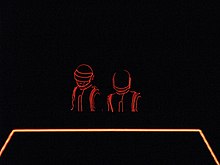
Daft Punk appeared on the 2016 singles "Starboy" and "I Feel It Coming" by Canadian R&B singer the Weeknd;[83][84] "Starboy" topped the Billboard Hot 100, becoming Daft Punk's only US number-one song, and "I Feel It Coming" reached number four.[85][86] In 2017, Soma Records released a previously unreleased remix of the Daft Punk track "Drive", as part of a compilation featuring various artists.[87][88]
PsNext 2.42
PsNext 2.42 theme by Roger Carvalho
Download: PsNext.p3t
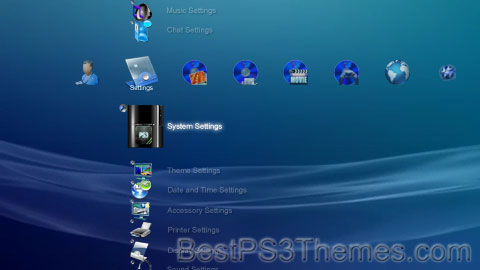
(no backgrounds)
P3T Unpacker v0.12
Copyright (c) 2007. Anoop Menon
This program unpacks Playstation 3 Theme files (.p3t) so that you can touch-up an existing theme to your likings or use a certain wallpaper from it (as many themes have multiple). But remember, if you use content from another theme and release it, be sure to give credit!
Download for Windows: p3textractor.zip
Instructions:
Download p3textractor.zip from above. Extract the files to a folder with a program such as WinZip or WinRAR. Now there are multiple ways to extract the theme.
The first way is to simply open the p3t file with p3textractor.exe. If you don’t know how to do this, right click the p3t file and select Open With. Alternatively, open the p3t file and it will ask you to select a program to open with. Click Browse and find p3textractor.exe from where you previously extracted it to. It will open CMD and extract the theme to extracted.[filename]. After that, all you need to do for any future p3t files is open them and it will extract.
The second way is very simple. Just drag the p3t file to p3textractor.exe. It will open CMD and extract the theme to extracted.[filename].
For the third way, first put the p3t file you want to extract into the same folder as p3textractor.exe. Open CMD and browse to the folder with p3extractor.exe. Enter the following:
p3textractor filename.p3t [destination path]Replace filename with the name of the p3t file, and replace [destination path] with the name of the folder you want the files to be extracted to. A destination path is not required. By default it will extract to extracted.filename.
Strike Witches: German Officers
Strike Witches: German Officers theme by ooberallen
Download: StrikeWitchesGO.p3t
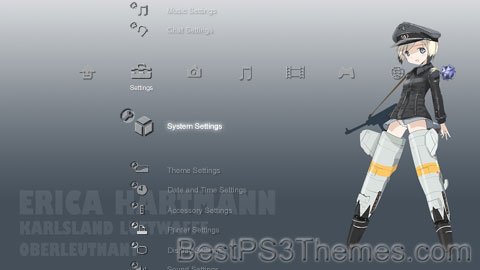
(3 backgrounds)
P3T Unpacker v0.12
Copyright (c) 2007. Anoop Menon
This program unpacks Playstation 3 Theme files (.p3t) so that you can touch-up an existing theme to your likings or use a certain wallpaper from it (as many themes have multiple). But remember, if you use content from another theme and release it, be sure to give credit!
Download for Windows: p3textractor.zip
Instructions:
Download p3textractor.zip from above. Extract the files to a folder with a program such as WinZip or WinRAR. Now there are multiple ways to extract the theme.
The first way is to simply open the p3t file with p3textractor.exe. If you don’t know how to do this, right click the p3t file and select Open With. Alternatively, open the p3t file and it will ask you to select a program to open with. Click Browse and find p3textractor.exe from where you previously extracted it to. It will open CMD and extract the theme to extracted.[filename]. After that, all you need to do for any future p3t files is open them and it will extract.
The second way is very simple. Just drag the p3t file to p3textractor.exe. It will open CMD and extract the theme to extracted.[filename].
For the third way, first put the p3t file you want to extract into the same folder as p3textractor.exe. Open CMD and browse to the folder with p3extractor.exe. Enter the following:
p3textractor filename.p3t [destination path]Replace filename with the name of the p3t file, and replace [destination path] with the name of the folder you want the files to be extracted to. A destination path is not required. By default it will extract to extracted.filename.
Red Hulk Saga
Red Hulk Saga theme by Zhero
Download: RedHulkSaga.p3t
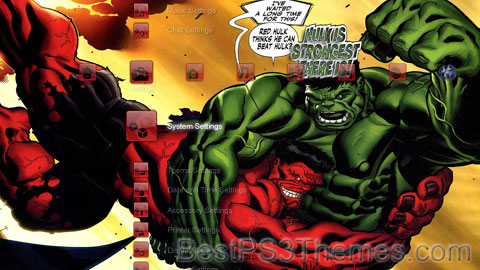
(11 backgrounds)
P3T Unpacker v0.12
Copyright (c) 2007. Anoop Menon
This program unpacks Playstation 3 Theme files (.p3t) so that you can touch-up an existing theme to your likings or use a certain wallpaper from it (as many themes have multiple). But remember, if you use content from another theme and release it, be sure to give credit!
Download for Windows: p3textractor.zip
Instructions:
Download p3textractor.zip from above. Extract the files to a folder with a program such as WinZip or WinRAR. Now there are multiple ways to extract the theme.
The first way is to simply open the p3t file with p3textractor.exe. If you don’t know how to do this, right click the p3t file and select Open With. Alternatively, open the p3t file and it will ask you to select a program to open with. Click Browse and find p3textractor.exe from where you previously extracted it to. It will open CMD and extract the theme to extracted.[filename]. After that, all you need to do for any future p3t files is open them and it will extract.
The second way is very simple. Just drag the p3t file to p3textractor.exe. It will open CMD and extract the theme to extracted.[filename].
For the third way, first put the p3t file you want to extract into the same folder as p3textractor.exe. Open CMD and browse to the folder with p3extractor.exe. Enter the following:
p3textractor filename.p3t [destination path]Replace filename with the name of the p3t file, and replace [destination path] with the name of the folder you want the files to be extracted to. A destination path is not required. By default it will extract to extracted.filename.
TMNT by DK
TMNT theme by Daniel Keen
Download: TMNT_DK.p3t
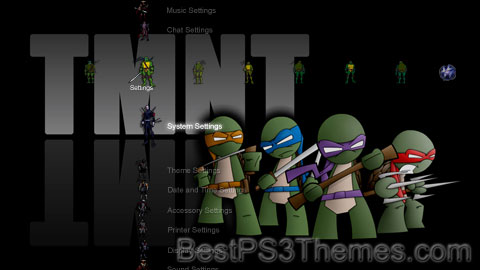
(2 backgrounds)
P3T Unpacker v0.12
Copyright (c) 2007. Anoop Menon
This program unpacks Playstation 3 Theme files (.p3t) so that you can touch-up an existing theme to your likings or use a certain wallpaper from it (as many themes have multiple). But remember, if you use content from another theme and release it, be sure to give credit!
Download for Windows: p3textractor.zip
Instructions:
Download p3textractor.zip from above. Extract the files to a folder with a program such as WinZip or WinRAR. Now there are multiple ways to extract the theme.
The first way is to simply open the p3t file with p3textractor.exe. If you don’t know how to do this, right click the p3t file and select Open With. Alternatively, open the p3t file and it will ask you to select a program to open with. Click Browse and find p3textractor.exe from where you previously extracted it to. It will open CMD and extract the theme to extracted.[filename]. After that, all you need to do for any future p3t files is open them and it will extract.
The second way is very simple. Just drag the p3t file to p3textractor.exe. It will open CMD and extract the theme to extracted.[filename].
For the third way, first put the p3t file you want to extract into the same folder as p3textractor.exe. Open CMD and browse to the folder with p3extractor.exe. Enter the following:
p3textractor filename.p3t [destination path]Replace filename with the name of the p3t file, and replace [destination path] with the name of the folder you want the files to be extracted to. A destination path is not required. By default it will extract to extracted.filename.
Lara Croft Worship
Lara Croft Worship theme by Ryan Malin (BrushYourTeeth)
Download: LaraCroftWorship.p3t
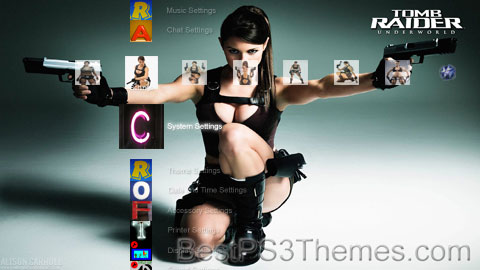
(10 backgrounds)
P3T Unpacker v0.12
Copyright (c) 2007. Anoop Menon
This program unpacks Playstation 3 Theme files (.p3t) so that you can touch-up an existing theme to your likings or use a certain wallpaper from it (as many themes have multiple). But remember, if you use content from another theme and release it, be sure to give credit!
Download for Windows: p3textractor.zip
Instructions:
Download p3textractor.zip from above. Extract the files to a folder with a program such as WinZip or WinRAR. Now there are multiple ways to extract the theme.
The first way is to simply open the p3t file with p3textractor.exe. If you don’t know how to do this, right click the p3t file and select Open With. Alternatively, open the p3t file and it will ask you to select a program to open with. Click Browse and find p3textractor.exe from where you previously extracted it to. It will open CMD and extract the theme to extracted.[filename]. After that, all you need to do for any future p3t files is open them and it will extract.
The second way is very simple. Just drag the p3t file to p3textractor.exe. It will open CMD and extract the theme to extracted.[filename].
For the third way, first put the p3t file you want to extract into the same folder as p3textractor.exe. Open CMD and browse to the folder with p3extractor.exe. Enter the following:
p3textractor filename.p3t [destination path]Replace filename with the name of the p3t file, and replace [destination path] with the name of the folder you want the files to be extracted to. A destination path is not required. By default it will extract to extracted.filename.
Talbot TMNT by DK II
Talbot TMNT by DK II theme by Daniel Keen
Download: TalbotTMNTII.p3t
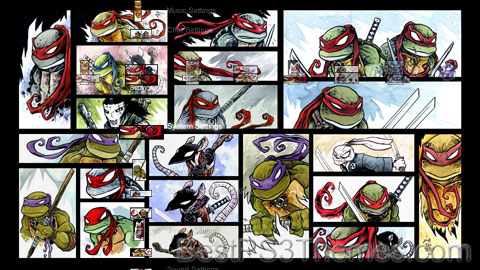
(2 backgrounds)
P3T Unpacker v0.12
Copyright (c) 2007. Anoop Menon
This program unpacks Playstation 3 Theme files (.p3t) so that you can touch-up an existing theme to your likings or use a certain wallpaper from it (as many themes have multiple). But remember, if you use content from another theme and release it, be sure to give credit!
Download for Windows: p3textractor.zip
Instructions:
Download p3textractor.zip from above. Extract the files to a folder with a program such as WinZip or WinRAR. Now there are multiple ways to extract the theme.
The first way is to simply open the p3t file with p3textractor.exe. If you don’t know how to do this, right click the p3t file and select Open With. Alternatively, open the p3t file and it will ask you to select a program to open with. Click Browse and find p3textractor.exe from where you previously extracted it to. It will open CMD and extract the theme to extracted.[filename]. After that, all you need to do for any future p3t files is open them and it will extract.
The second way is very simple. Just drag the p3t file to p3textractor.exe. It will open CMD and extract the theme to extracted.[filename].
For the third way, first put the p3t file you want to extract into the same folder as p3textractor.exe. Open CMD and browse to the folder with p3extractor.exe. Enter the following:
p3textractor filename.p3t [destination path]Replace filename with the name of the p3t file, and replace [destination path] with the name of the folder you want the files to be extracted to. A destination path is not required. By default it will extract to extracted.filename.
Talbot TMNT by DK
Talbot TMNT by DK theme by Daniel Keen
Download: TalbotTMNT.p3t
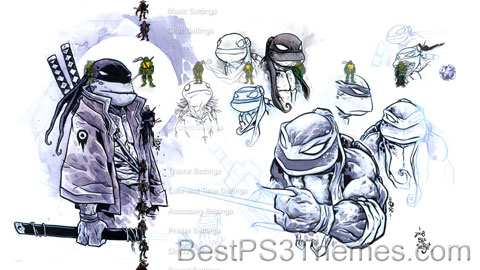
(2 backgrounds)
P3T Unpacker v0.12
Copyright (c) 2007. Anoop Menon
This program unpacks Playstation 3 Theme files (.p3t) so that you can touch-up an existing theme to your likings or use a certain wallpaper from it (as many themes have multiple). But remember, if you use content from another theme and release it, be sure to give credit!
Download for Windows: p3textractor.zip
Instructions:
Download p3textractor.zip from above. Extract the files to a folder with a program such as WinZip or WinRAR. Now there are multiple ways to extract the theme.
The first way is to simply open the p3t file with p3textractor.exe. If you don’t know how to do this, right click the p3t file and select Open With. Alternatively, open the p3t file and it will ask you to select a program to open with. Click Browse and find p3textractor.exe from where you previously extracted it to. It will open CMD and extract the theme to extracted.[filename]. After that, all you need to do for any future p3t files is open them and it will extract.
The second way is very simple. Just drag the p3t file to p3textractor.exe. It will open CMD and extract the theme to extracted.[filename].
For the third way, first put the p3t file you want to extract into the same folder as p3textractor.exe. Open CMD and browse to the folder with p3extractor.exe. Enter the following:
p3textractor filename.p3t [destination path]Replace filename with the name of the p3t file, and replace [destination path] with the name of the folder you want the files to be extracted to. A destination path is not required. By default it will extract to extracted.filename.
Civilopedia
Civilopedia theme by SCHoTZ
Download: Civilopedia.p3t
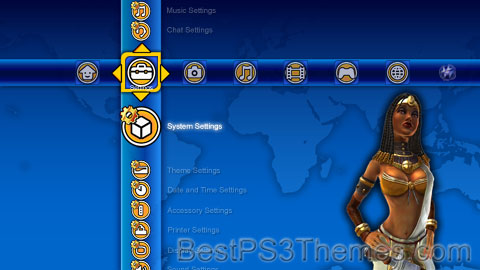
(3 backgrounds)
P3T Unpacker v0.12
Copyright (c) 2007. Anoop Menon
This program unpacks Playstation 3 Theme files (.p3t) so that you can touch-up an existing theme to your likings or use a certain wallpaper from it (as many themes have multiple). But remember, if you use content from another theme and release it, be sure to give credit!
Download for Windows: p3textractor.zip
Instructions:
Download p3textractor.zip from above. Extract the files to a folder with a program such as WinZip or WinRAR. Now there are multiple ways to extract the theme.
The first way is to simply open the p3t file with p3textractor.exe. If you don’t know how to do this, right click the p3t file and select Open With. Alternatively, open the p3t file and it will ask you to select a program to open with. Click Browse and find p3textractor.exe from where you previously extracted it to. It will open CMD and extract the theme to extracted.[filename]. After that, all you need to do for any future p3t files is open them and it will extract.
The second way is very simple. Just drag the p3t file to p3textractor.exe. It will open CMD and extract the theme to extracted.[filename].
For the third way, first put the p3t file you want to extract into the same folder as p3textractor.exe. Open CMD and browse to the folder with p3extractor.exe. Enter the following:
p3textractor filename.p3t [destination path]Replace filename with the name of the p3t file, and replace [destination path] with the name of the folder you want the files to be extracted to. A destination path is not required. By default it will extract to extracted.filename.
